Article first published in August 2017, updated June 2019
Marketers understand that people rarely purchase after their first touch with a website or brand. Consumers need nurturing at multiple stages throughout the purchase funnel.
Lifecycle marketing allows companies to send multiple emails with the goal of educating prospects so they understand what the company offers and how it can help them succeed. In other words, companies use lifecycle marketing to increase the likelihood of purchase, increase retention, and lifetime value.
But, as Anthony Nygren, from EMI Strategic Marketing, says, “Lifecycle Marketing isn’t just about sending messages customers might like—it’s about positively influencing their behavior.”
Lifecycle marketing campaigns aren’t one-size-fits-all tactics that you can just plug and play. You must adapt each campaign to your industry, your personas, and your specific goals. With that said, let’s take a moment to touch on the basics of lifecycle marketing and what it means for your brand and your prospects.
What is lifecycle marketing
We touched on what lifecycle marketing is; however, there’s so much more to it. Lifecycle marketing helps marketers guide potential customers through specific milestones in their sales funnel or brand relationship.
What is the marketing lifecycle?
In short, the marketing life cycle is designed to help marketers address their audience’s specific needs as they go from a prospect to a subscriber through to a loyal customer. Of course, the cycle isn’t that simple—while we wish it went that smoothly, the marketing life cycle also must include the indecisive customer, lapsed customers, repeat customers, and more.
This lifecycle marketing model shows us just how complicated the cycle can be, especially once you’ve aligned it to your many marketing channels.
 Source: Smart Insights
Source: Smart Insights
What are the stages of the customer lifecycle journey?
Now, as intimidating as that model may look, that’s the reality of having a business with multiple channels to it. For those starting small, you’ll want to begin by addressing the most common stages of the customer lifecycle journey, and then align it to your brand’s marketing goals.
The typical stages of the customer lifecycle journey look a little something like this.
Source: Alexa
Each stage is an essential piece of the lifecycle marketing process, so having a basic understanding of each is crucial.
- Brand awareness – your prospect first learns of your brand and products/services
- Brand engagement – your prospect begins interacting with your brand, possibly through subscribing to your email list
- Customer evaluation of the brand – Prospects will evaluate what you have to offer them and decide if it’s worth making the conversion.
- Customer purchase – After the evaluation process, they’ll hopefully choose to make a purchase.
- Post-purchase experience – The brand will want to reach out to the consumer to ensure their expectations have been met.
- Customer advocacy – If all goes well and your brand has a happy customer, then they’ll begin to spread the word of their experience to those around them.
In this post, you’ll learn ten examples of companies that use lifecycle marketing to communicate with their subscribers and customers.
Software
Campaign Monitor
A great way to learn about lifecycle marketing is from Campaign Monitor. I’ve been using it to promote my personal blog for some time and, recently, I decided to use it to launch a new email-based personal project of mine.
After I signed up, I immediately received a welcome email. It starts with a warm thank you that includes some social proof. Then it recommends three clear ways to get started. Since it’s common for people to have questions before getting started with any tool, Campaign Monitor also offers customer support help, in case you need it.
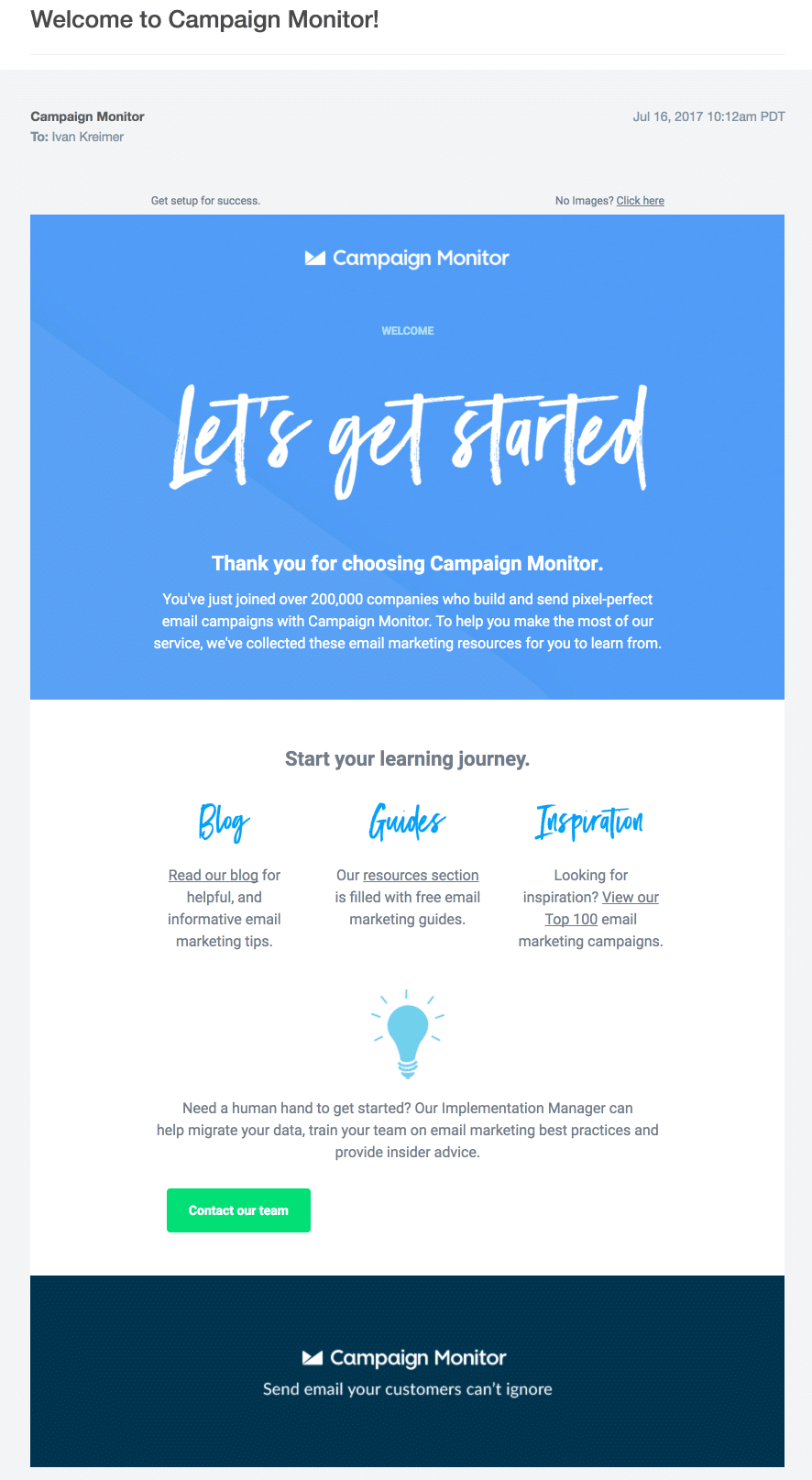
After I sent my first campaign, I was reminded to analyze the results, which was both helpful and useful.
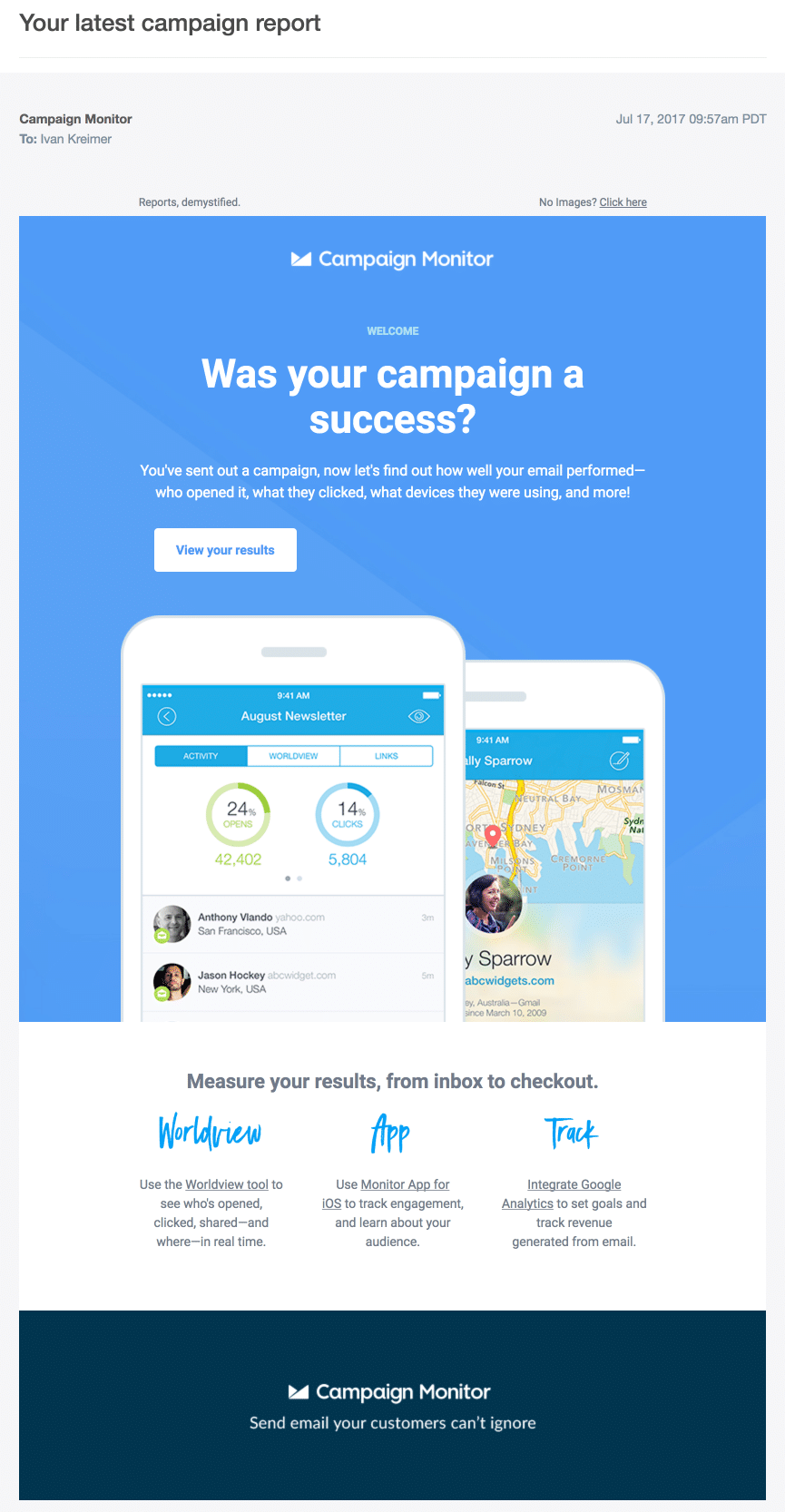
A day after I sent my campaign (which had been scheduled), I received a second email with a direct link to the analytics reporting, and a link to Worldview and the iOS app.
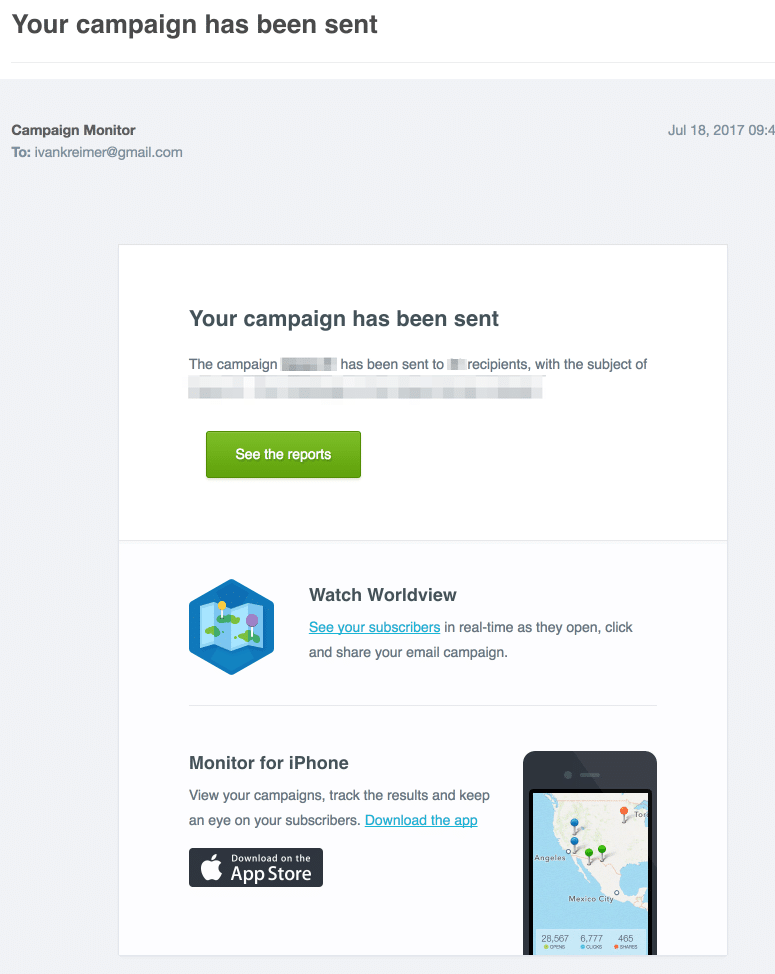
E-Commerce
Allbirds
is a shoe company from New Zealand that sells wool shoes that are all the rage with tech folks, millennials, and nearly everyone else.
The first email I received was a brief explanation of what they do and what they stand for. The email shared the company’s values rather than just talking about the product itself. They talk about their shoes, but from a value perspective (environmental sustainability, benefits of their shoes) and not about specific features. What I love about Allbirds is their values, so it makes sense they talk about them before they talk about their shoes.
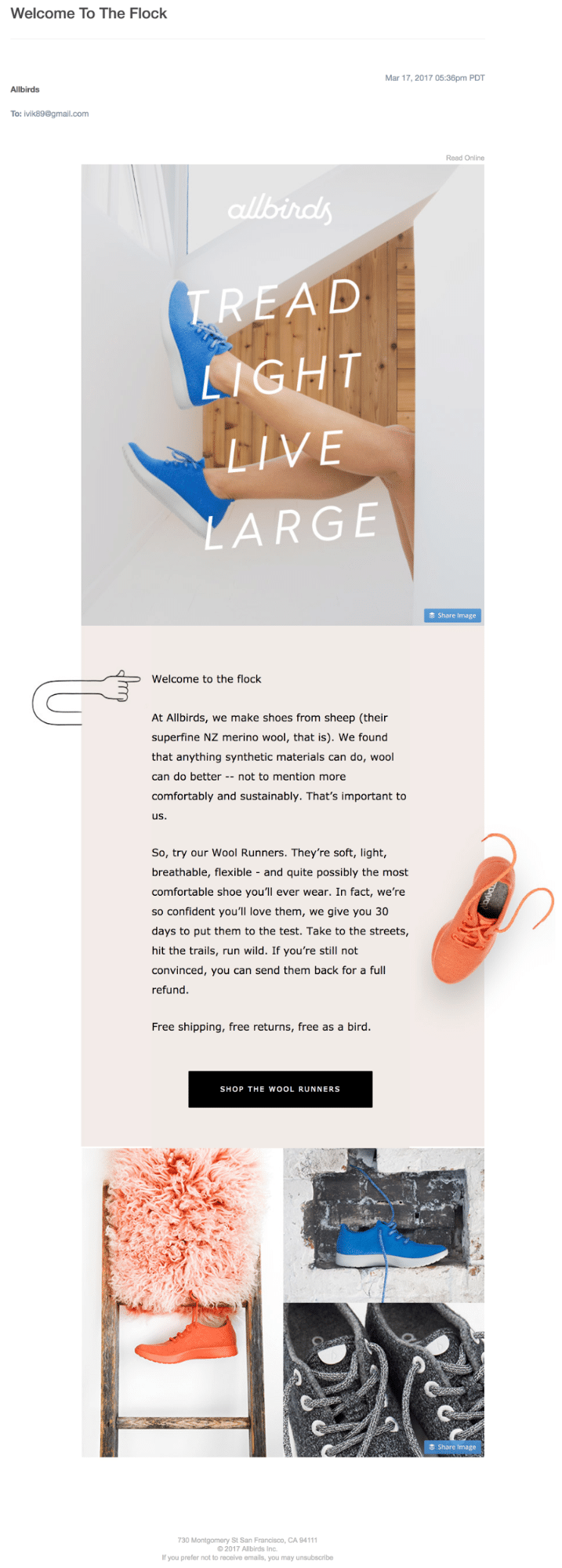
After I submitted my order, I received a standard order confirmation email. Simple and effective.
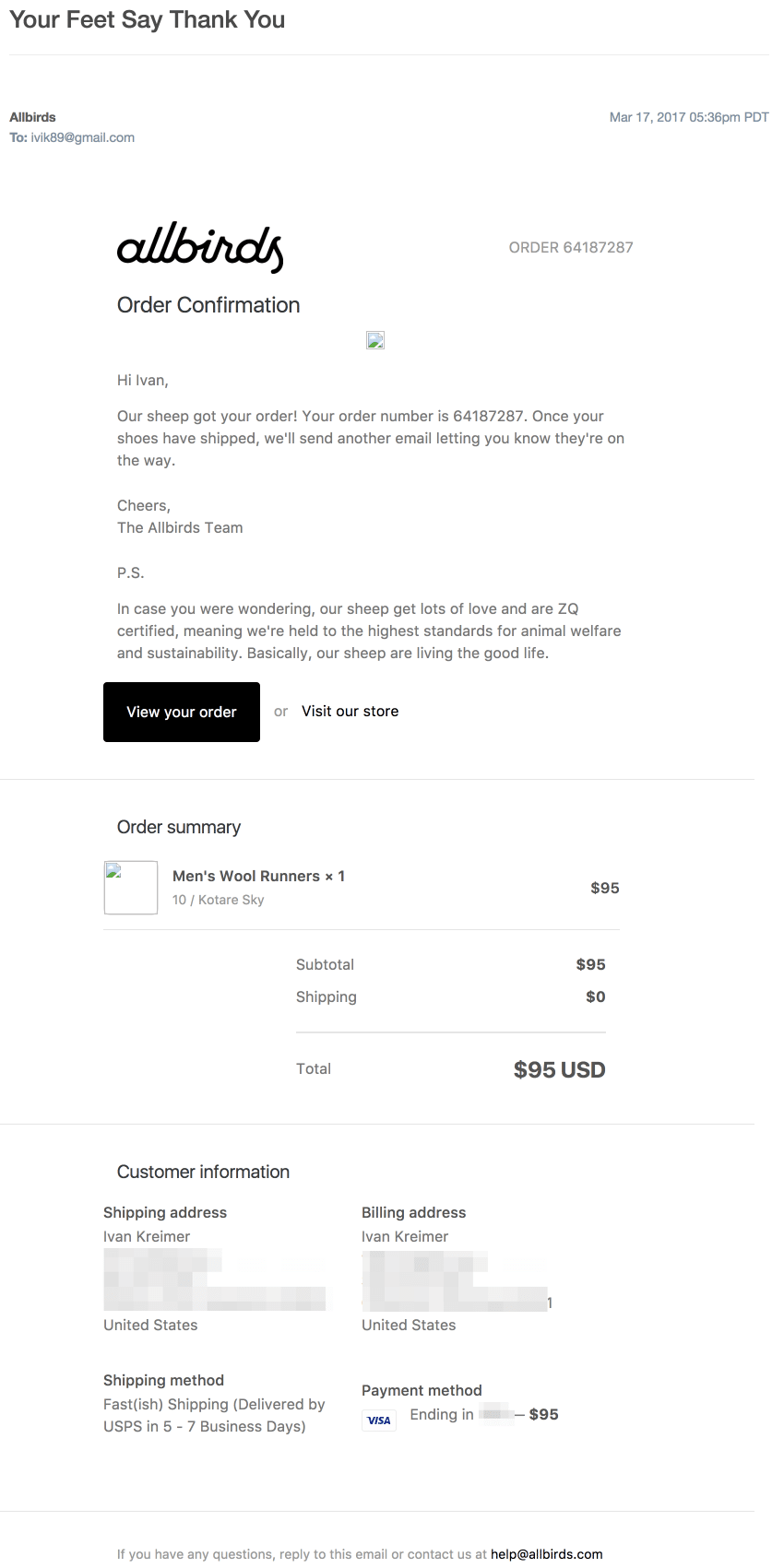
After my order shipped, I received another email providing me the tracking number.
What I didn’t receive is a product review email or education about the importance of wool and sustainability. It would’ve been great if I had but, so far, they’re a small company and their lifecycle marketing campaign is simple and effective.
Bodybuilding.com
is an online retailer specializing in dietary supplements, sports supplements, and bodybuilding supplements.
After I signed up for their newsletter, the first email I received was a thank you, with simple 1-2-3 steps: Browse their most popular products, see what new content they have, and find a training plan.
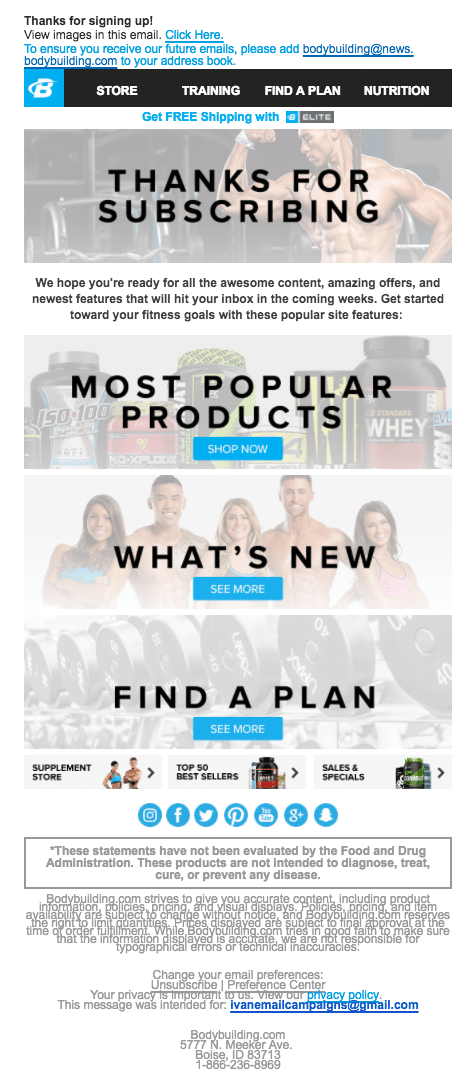
A few days later, I received an extensive news update with information about training, nutrition, and motivational content. Lastly, it contained a promotion.

The last email I received was purely sales-focused. It contained a large array of products available with a discount, mostly focused on pre-workout products.

All the subsequent emails I received were either news-focused or sales-focused.
Just Eat
is one of the largest online food delivery companies in the world, with a market valuation of over $5 billion.
After signing up for their service, I received a welcome email with my login credentials. This email could be even more effective if it recommended places close to my location, steps to order for the first time, and FAQs, among other things.
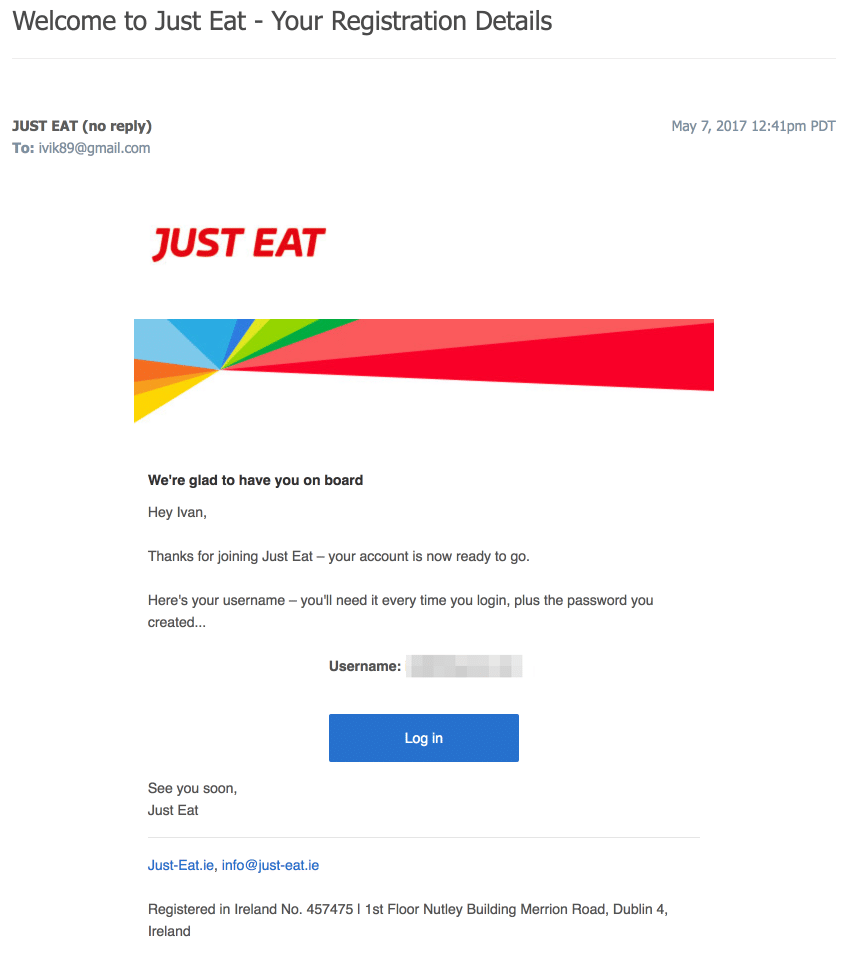
After I placed my first order, I received an email order confirmation with the details of the order, including the time of delivery, the food ordered, and the shipping destination.
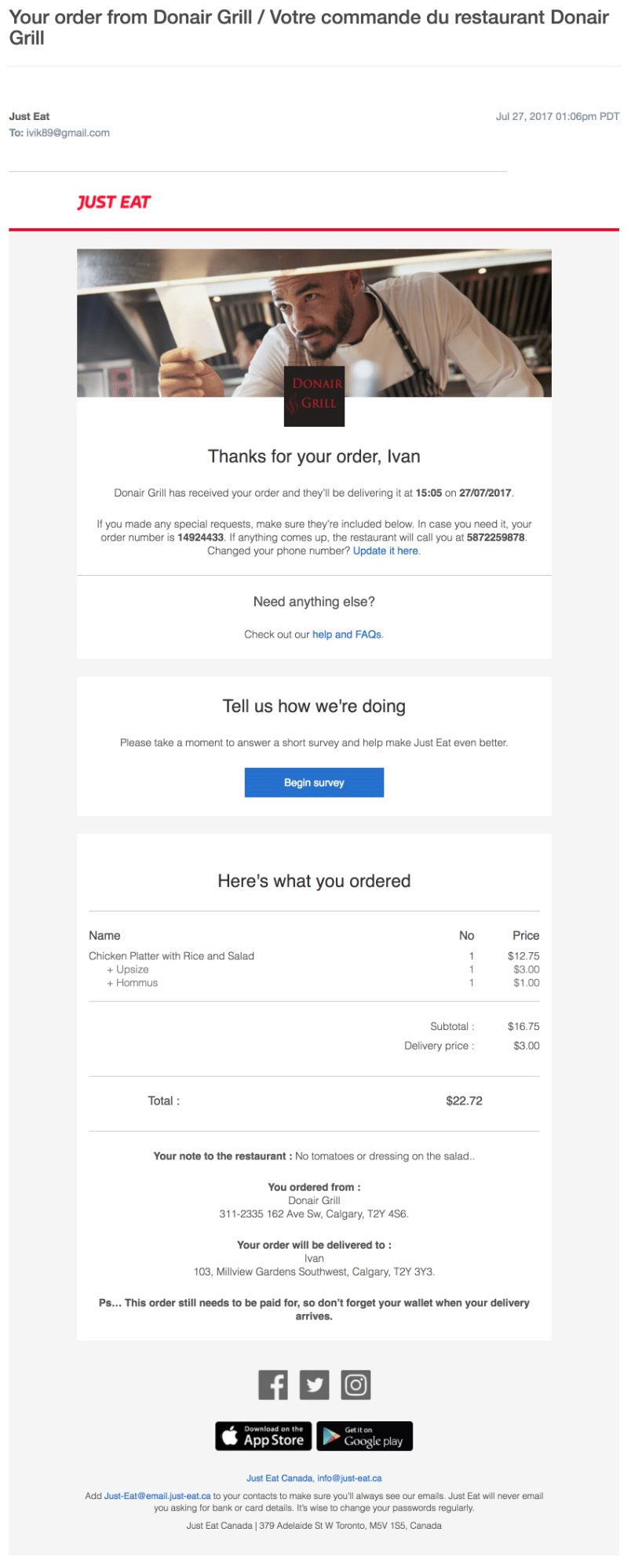
A few hours after I received the order, I received an email with an offer for my next order to incentivize a repeat purchase.
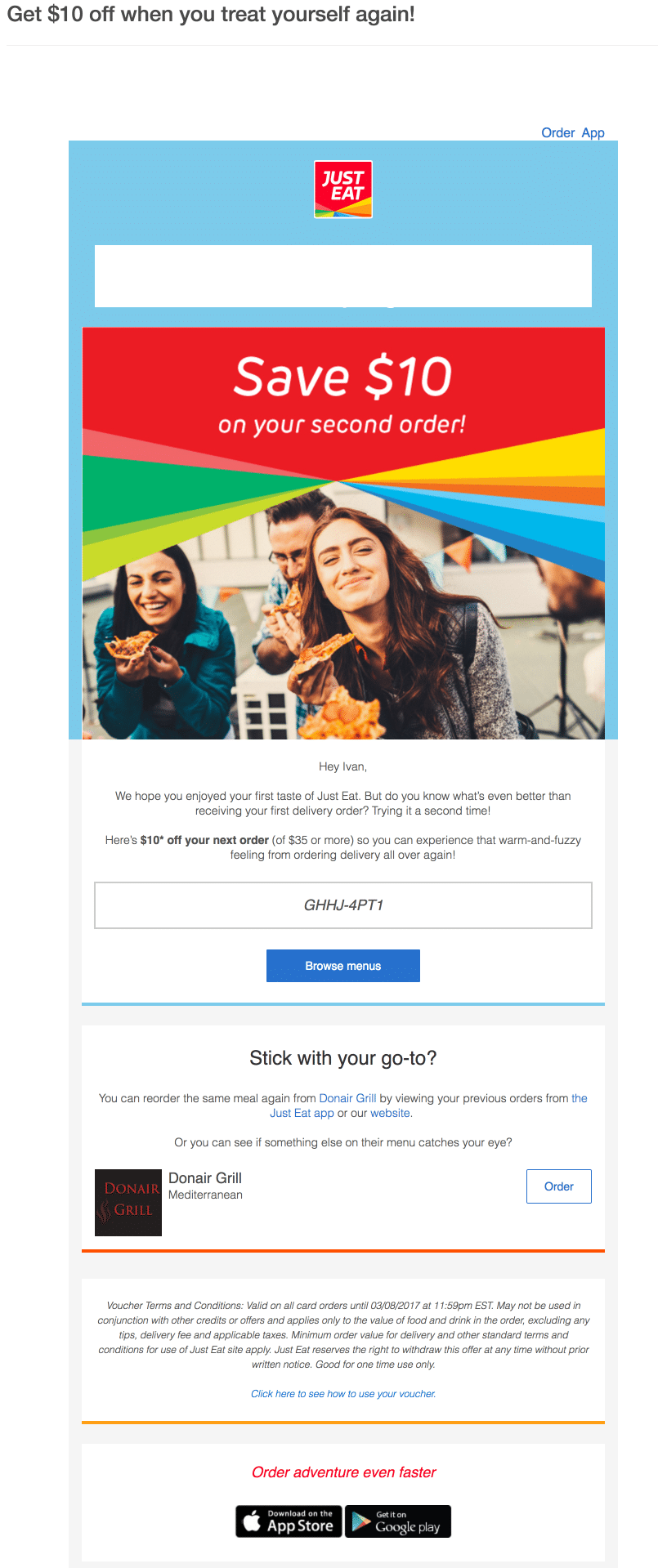
A day after my order, I received an email asking for a review. This is a smart move, as reviews are one of the most effective content types people use to make a purchase.
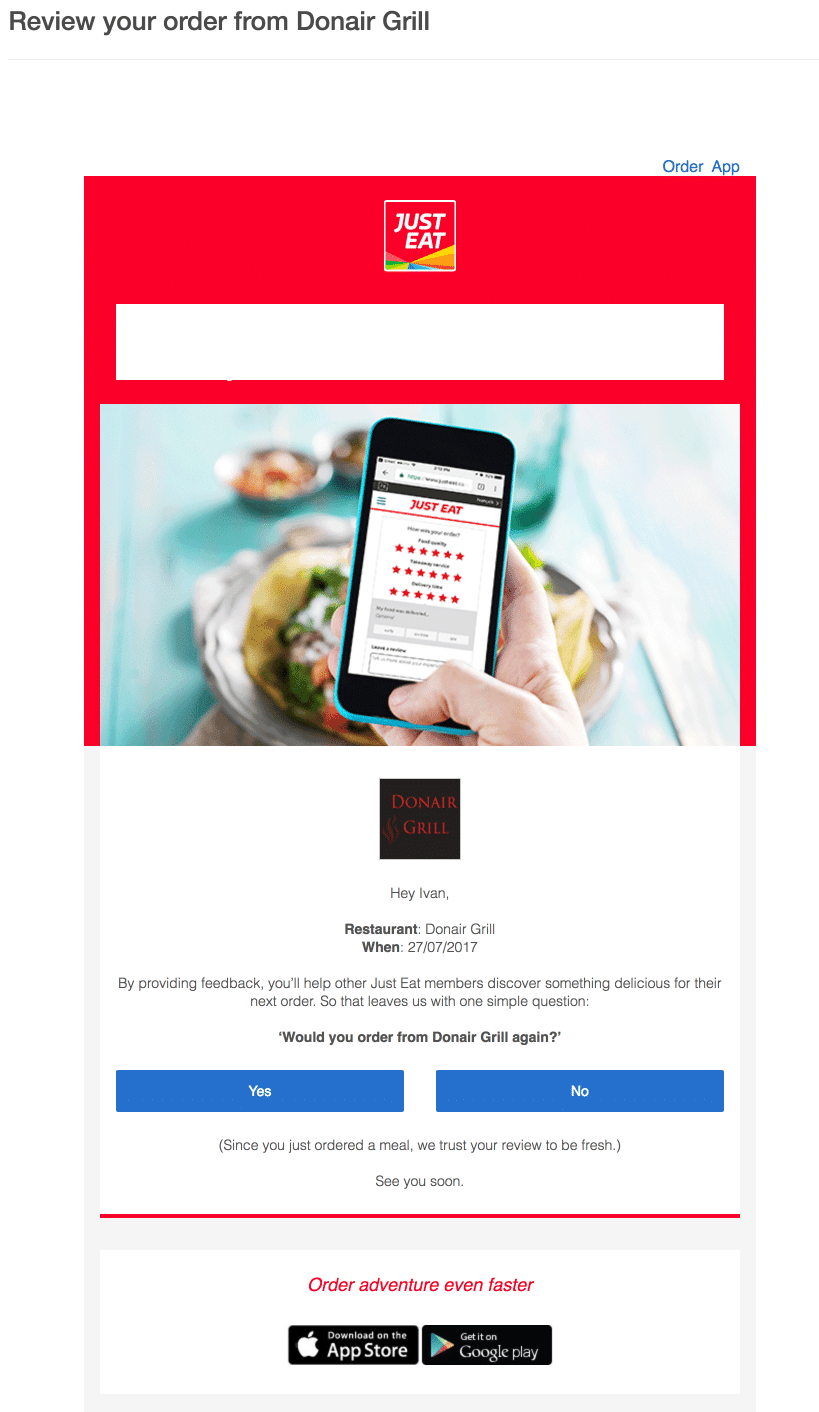
Nonprofit
Note: The example emails were sourced from Really Good Emails, Pinterest, and Charity Email Gallery.
Charity Water
is a nonprofit organization bringing clean, safe drinking water to people in developing countries.
The first email they send after signup says “Welcome, world changer.” It touches on one of Charity Water’s user goals: helping to change the world for the better. The image is quite emotional and shows the results of a potential donation, which motivates potential donors. It also uses the typical 1-2-3 steps we’ve seen, with three recommended actions to take: learning more about how they fund the projects, how they prove their donations, and how they rely on local experts.
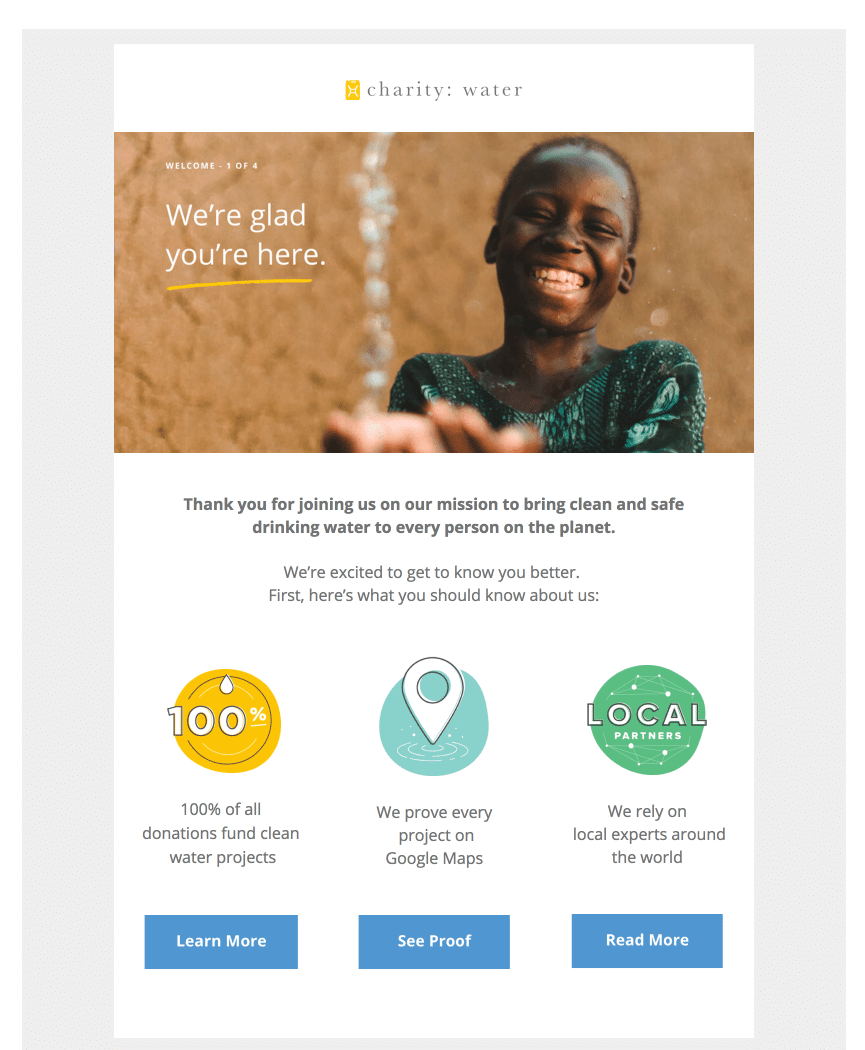
The second email is simple and specific: Donate water today and help someone in need. It’s simple but works well, given they know their subscribers care about the cause and it’s tied to Giving Tuesday, a specific nonprofit holiday.

The third email focuses on stories of children who’ve done the impossible to donate to the charity. It’s inspiring and emotional, which works great for nonprofits like Charity Water. By focusing on the importance of their cause, they persuade people to donate.

American Red Cross
is an important nonprofit organization that provides emergency assistance, disaster relief, and education in the United States.
The first email engages new subscribers with the values of the organization. They also set the expectations for what you can expect by being a subscriber, which is a great email marketing best practice. Surprisingly, they offer a discount for their online store, in which they sell emergency and first aid kits, among other related products. They close the first email with links to follow them on their social media channels, to donate, and volunteer.
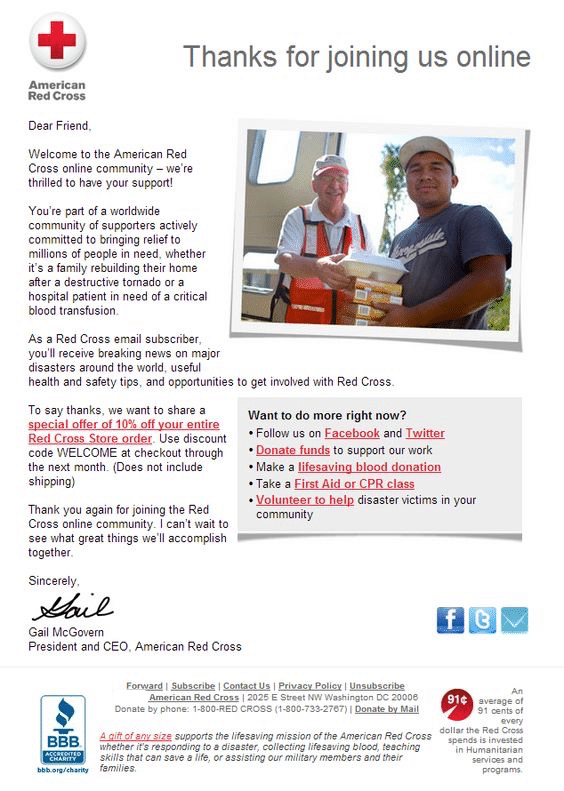
The following two emails sent are focused on donation campaigns. Both emails mention other donation and volunteering opportunities and news about their organization. Both emails are good, as they’re true to their organization’s goals (i.e., to get donations and volunteers).


WWF
The World Wide Fund for Nature
(WWF) is one of the largest nonprofits in the field of wilderness preservation and environmental protection.
The first email is a perfect example of a well-thought-out welcome email. It starts with a powerful message about protecting elephants and how you can help achieve the goal. Then WWF suggests a specific action: talking about why you want to help them protect the earth. Thanks to the power of commitment and consistency, this small action makes people more likely to continue volunteering and donating. It closes with the signature of an executive of the organization, which makes it even more compelling and powerful.
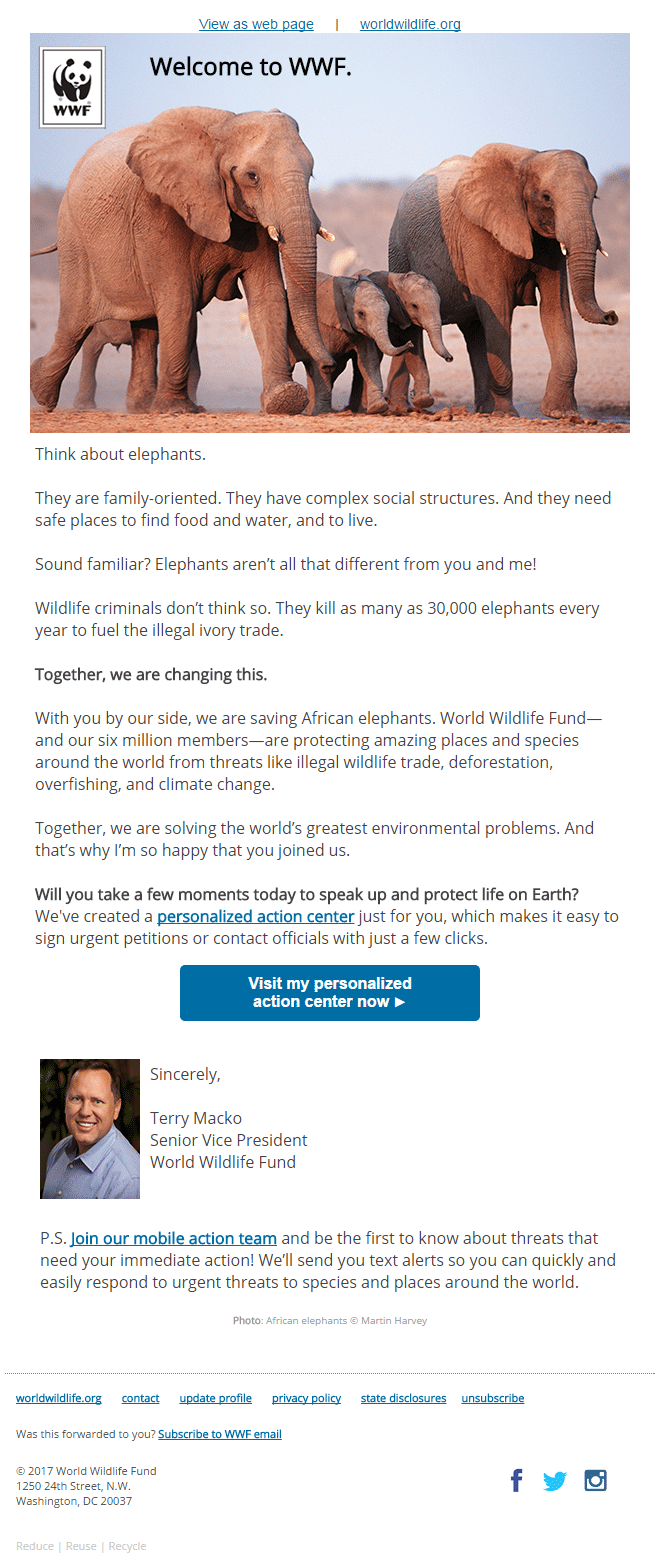
The second email is focused on making a donation to an important cause. Once again, they start with a visual picture. Triggering imagination and emotions help move people towards action. If they focused on the rational side (e.g., “You should donate because there are 1,000 turtles left), people may have a harder time doing something about the problem. They focus on the why (the purpose), not the what (the problem).
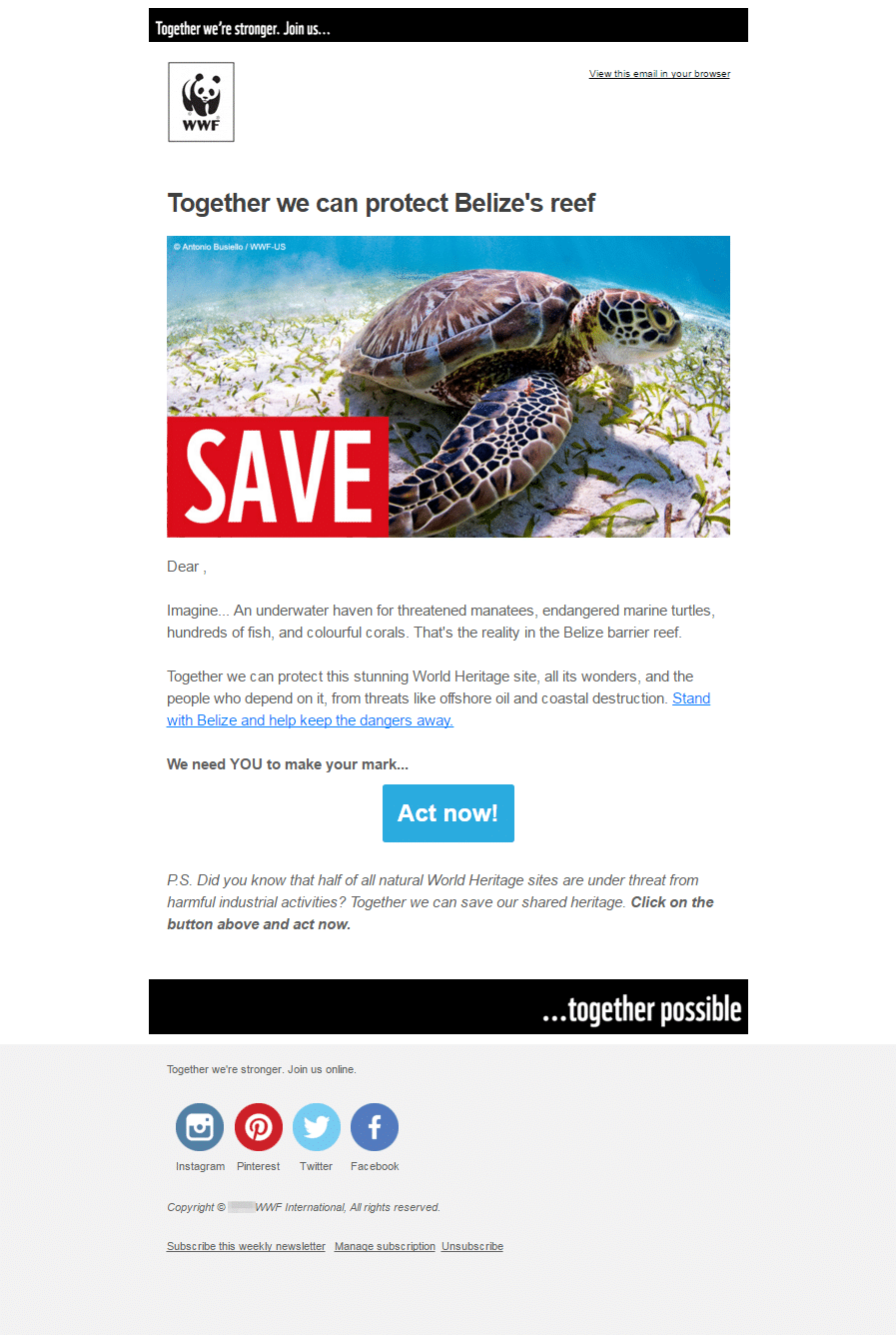
The third email focused on selling merchandise. What makes it effective is that they package up the merchandise in the form of a donation and focus it around a holiday.

Travel and Hospitality
Agoda
is travel fare aggregator selling destinations around the world.
After signing up, I didn’t receive a welcome email. But, after booked my first trip for a hostel in Singapore, I received a booking confirmation email. Besides the standard booking information, Agoda also suggests tasks for managing my booking details, customer service, and their site’s mobile apps.

A few days after my stay in the hostel, I received a second email asking for a review. This email is very simple and focused on encouraging me to write a review. They also explain how to write a review, which made it easier for me to do so.
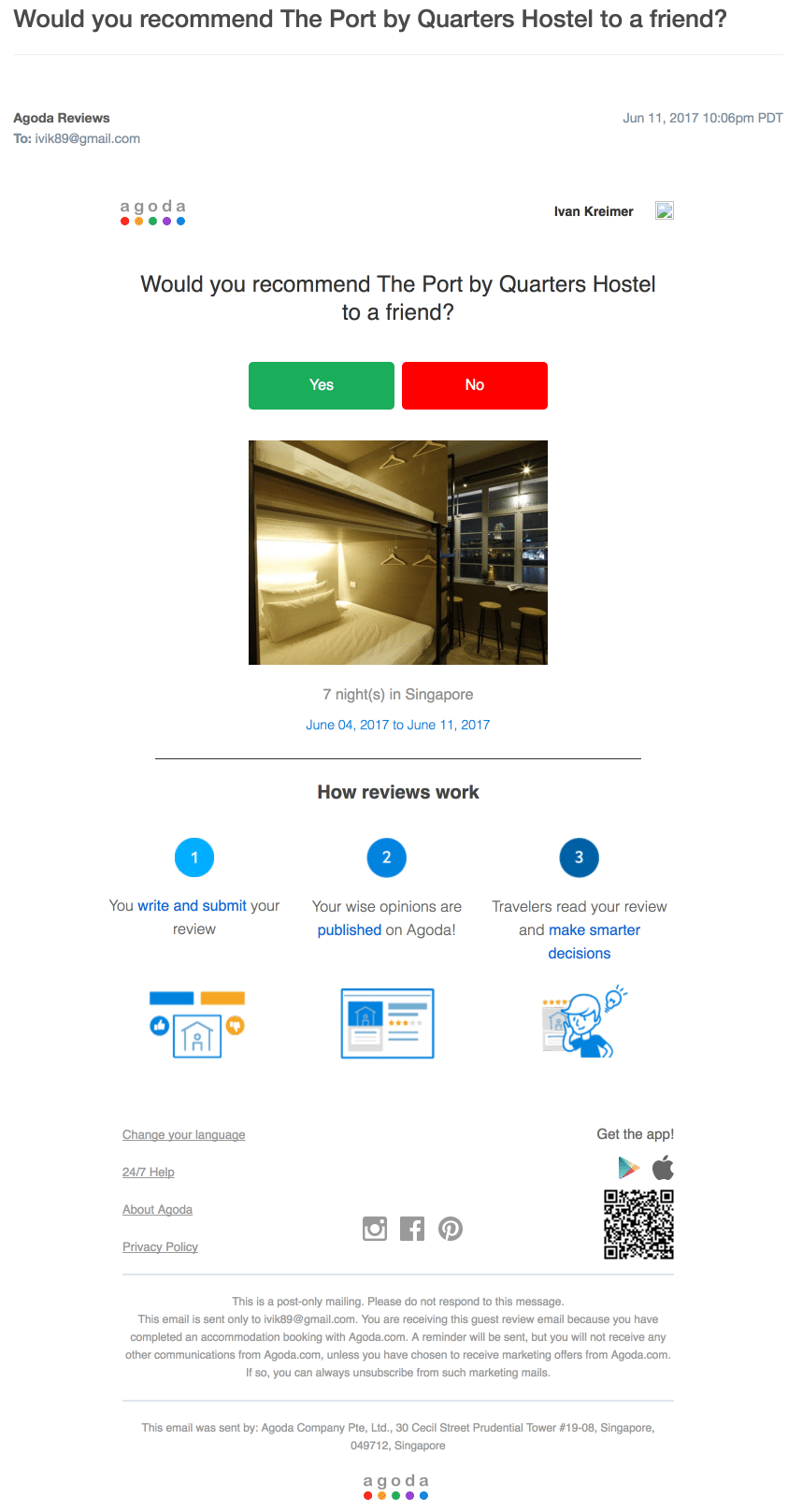
Booking
is one of the world’s largest travel fare aggregator websites and travel metasearch engines for the travel industry.
The first email I received wasn’t a welcome email, but a booking confirmation I made after opening an account with them. The email is long and detailed; most of the email is a mix of booking information and suggestions for changes in the booking. They mention everything about the reservation, including details of the hotel and its reservation rules and their own rules for changes, cancellations, and returns.

Later that day, I received a discount offer for other trips close to Kuala Lumpur, the location of the hotel I booked. This was one of the many offers I’ve received since then. That same day, I received a referral link to give out to my friends, which would help them both get a discount on a reservation. In this last email, they mention how the referral process works and why it matters, which makes it easier for me to use the referral link.
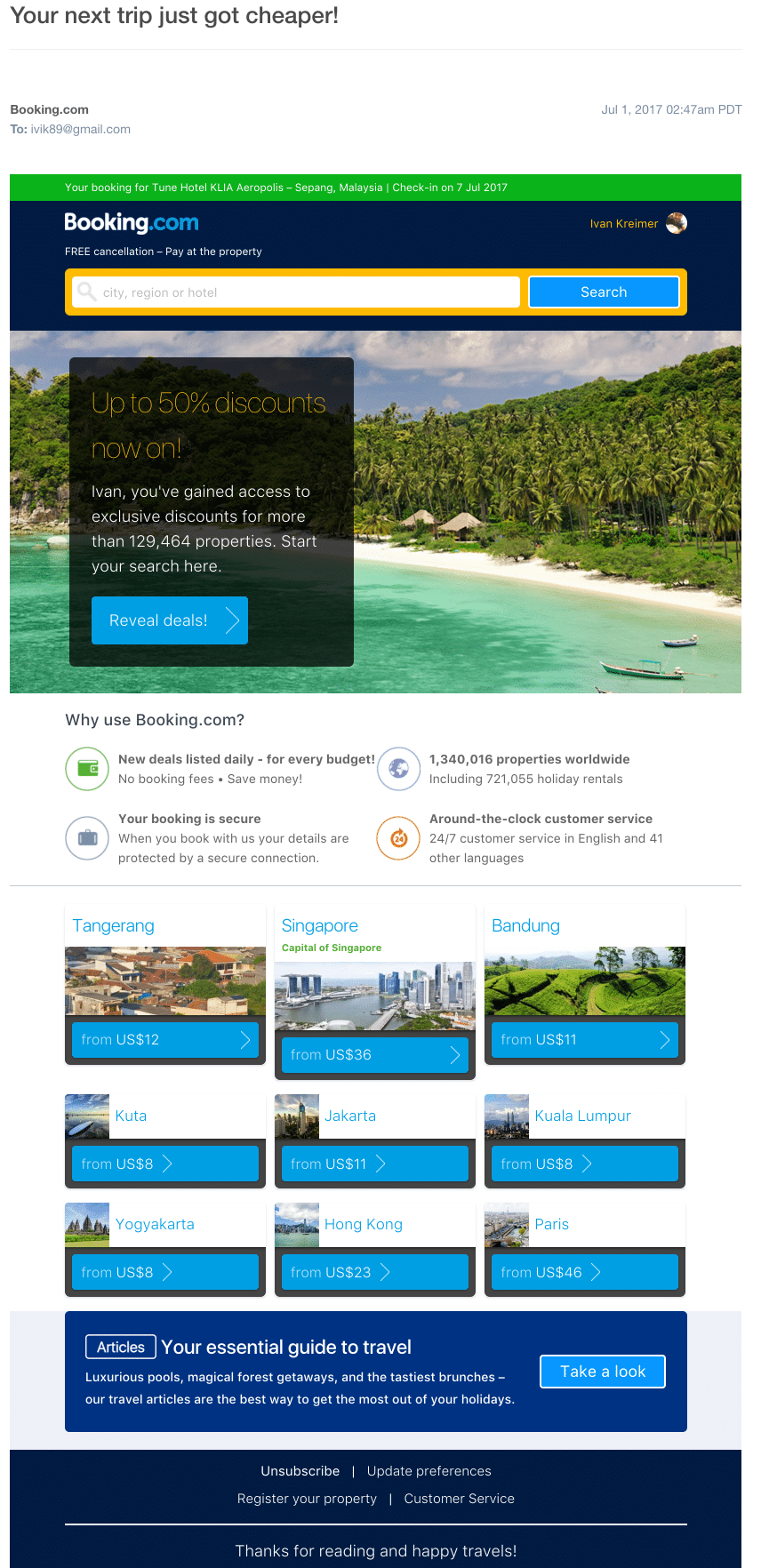
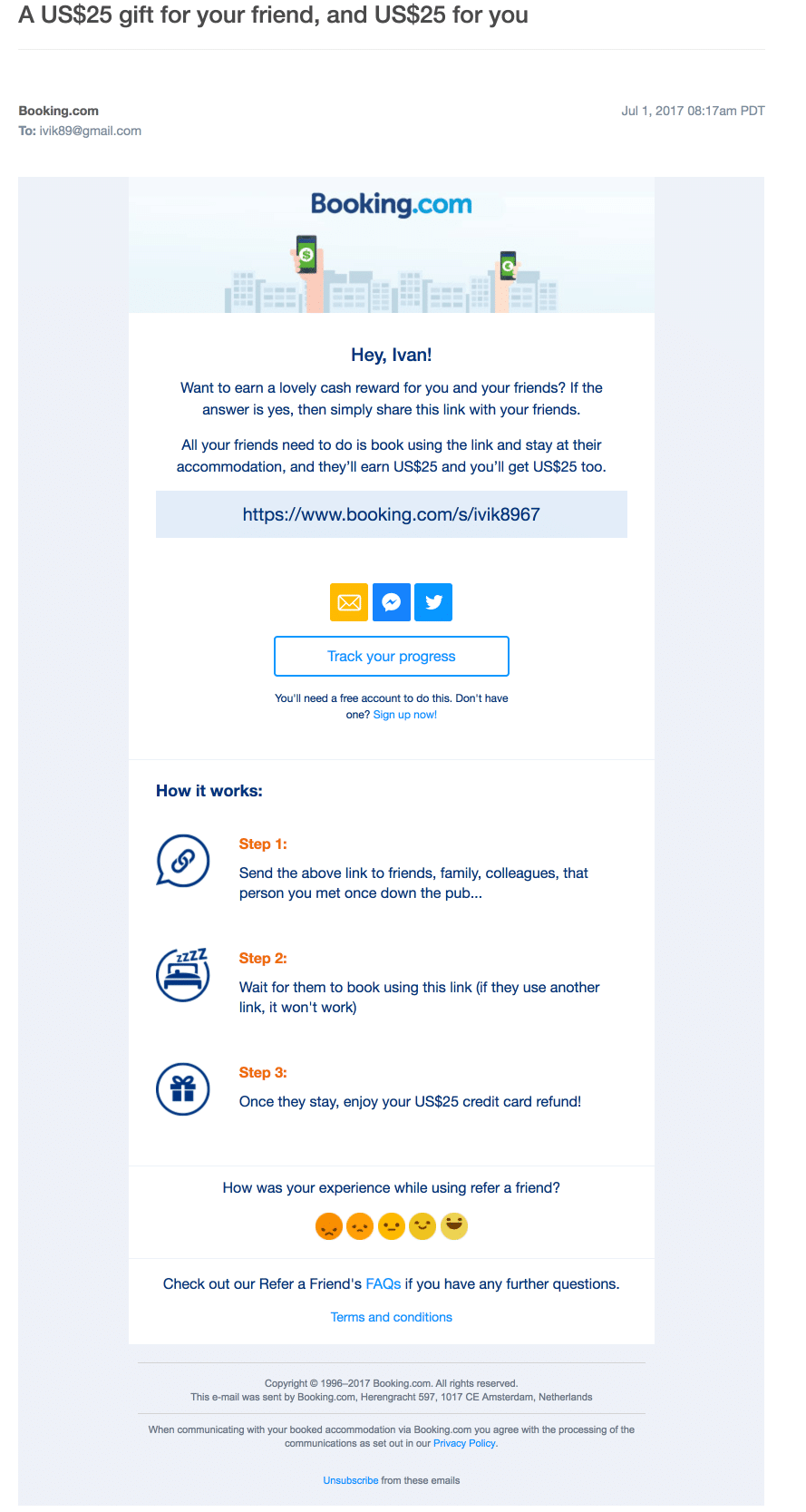
A day later, I received yet another offer and a reminder of the booking details, which was a few days away. They also suggested attractions in the city, which is useful for most tourists.
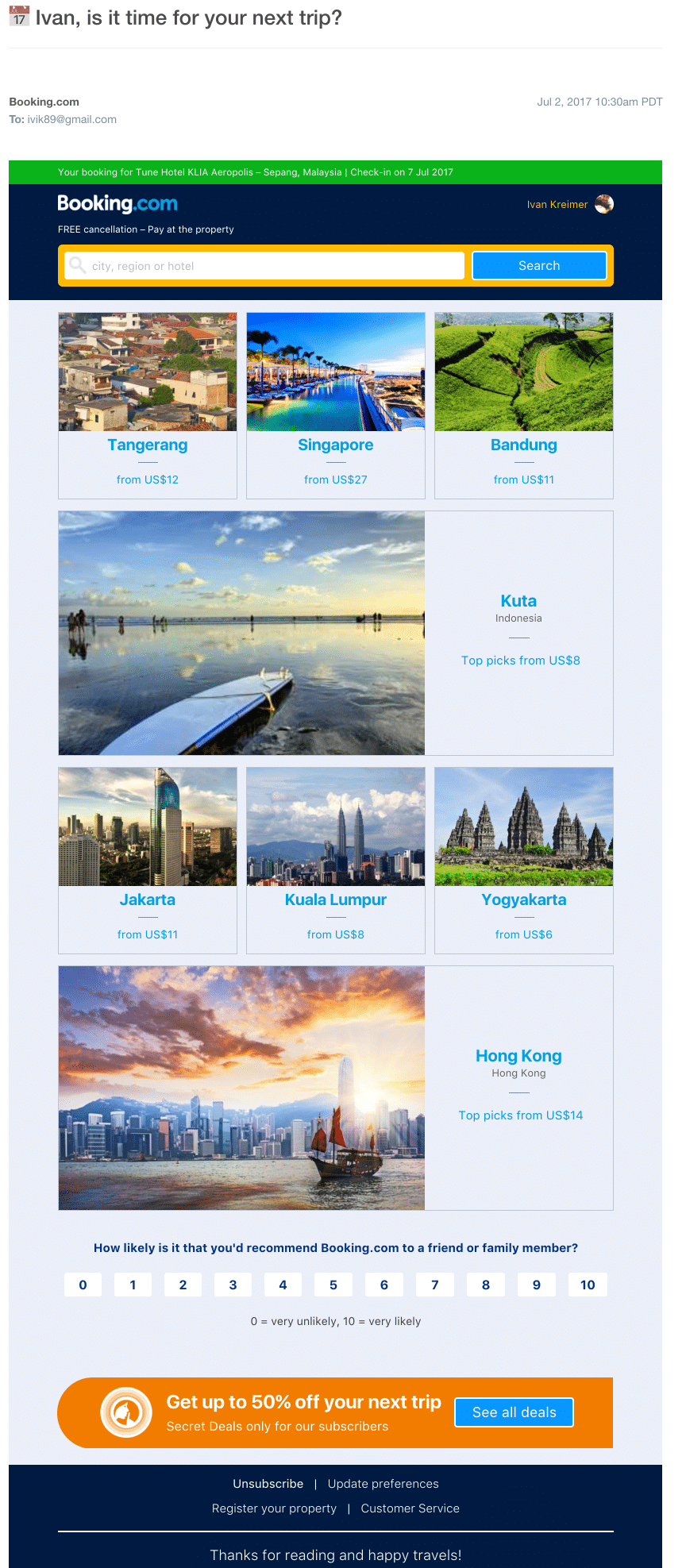
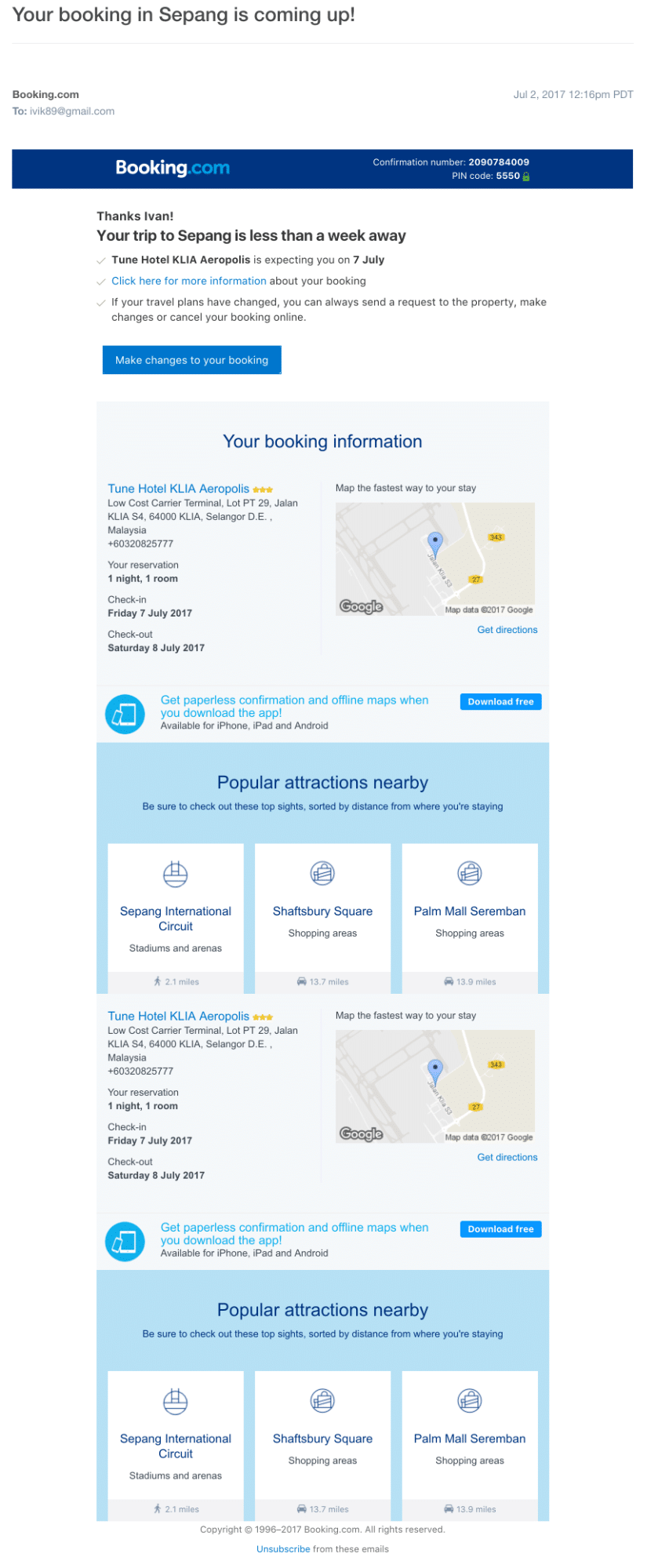
One day after my booking ended, they sent me an email asking for a review. After I gave a review, I received a thank you email. Both emails were simple and focused on the review.
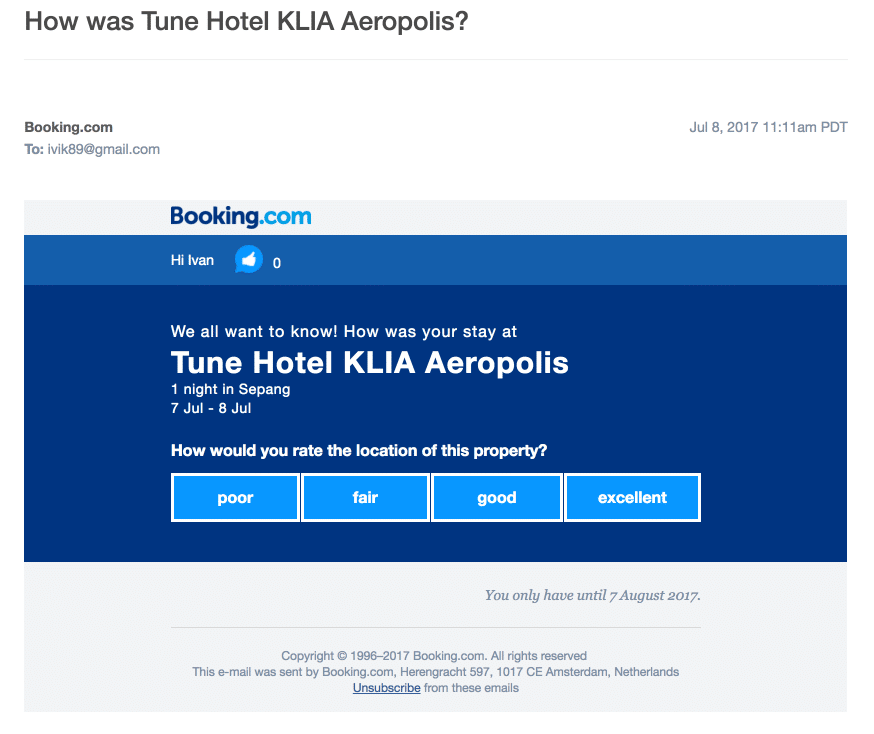
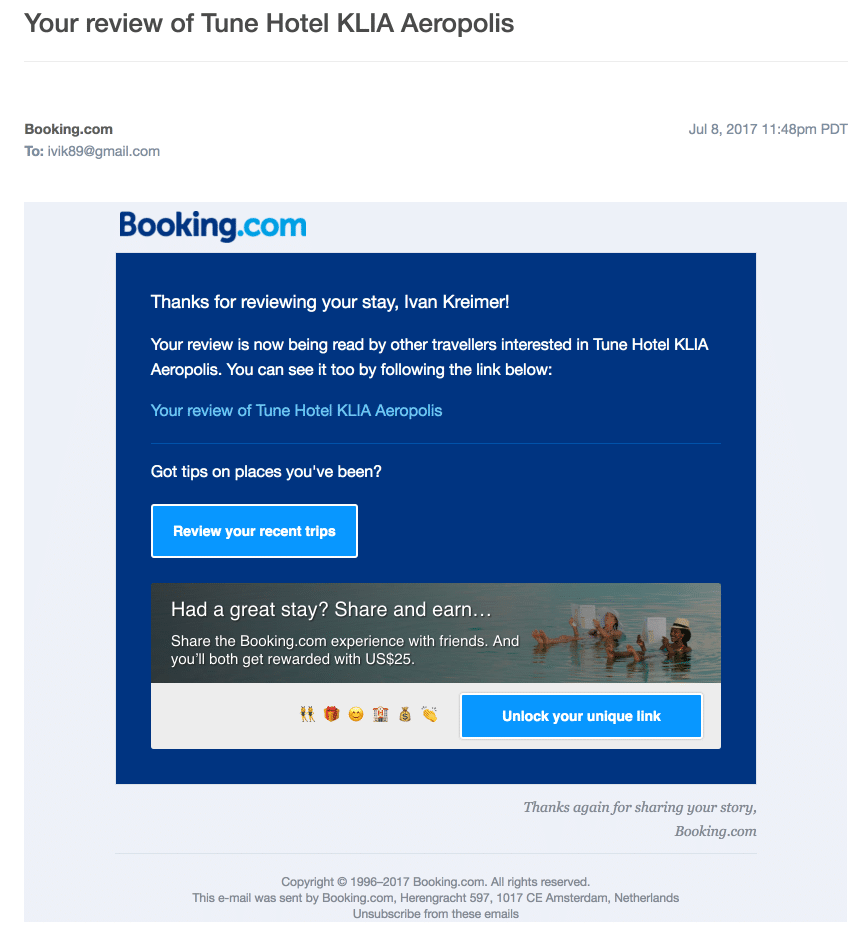
AirAsia
is one of the largest low-cost airlines in the Southeast Asia market.
The first email I received was a welcome email, which, like most of these emails, focused on giving help to new subscribers. In this case, they explain a few simple ways to accumulate points and how to redeem them, as well as how to make it easier to book and log in. Overall, it’s a useful email that helps a potential customer be more efficient in their bookings.
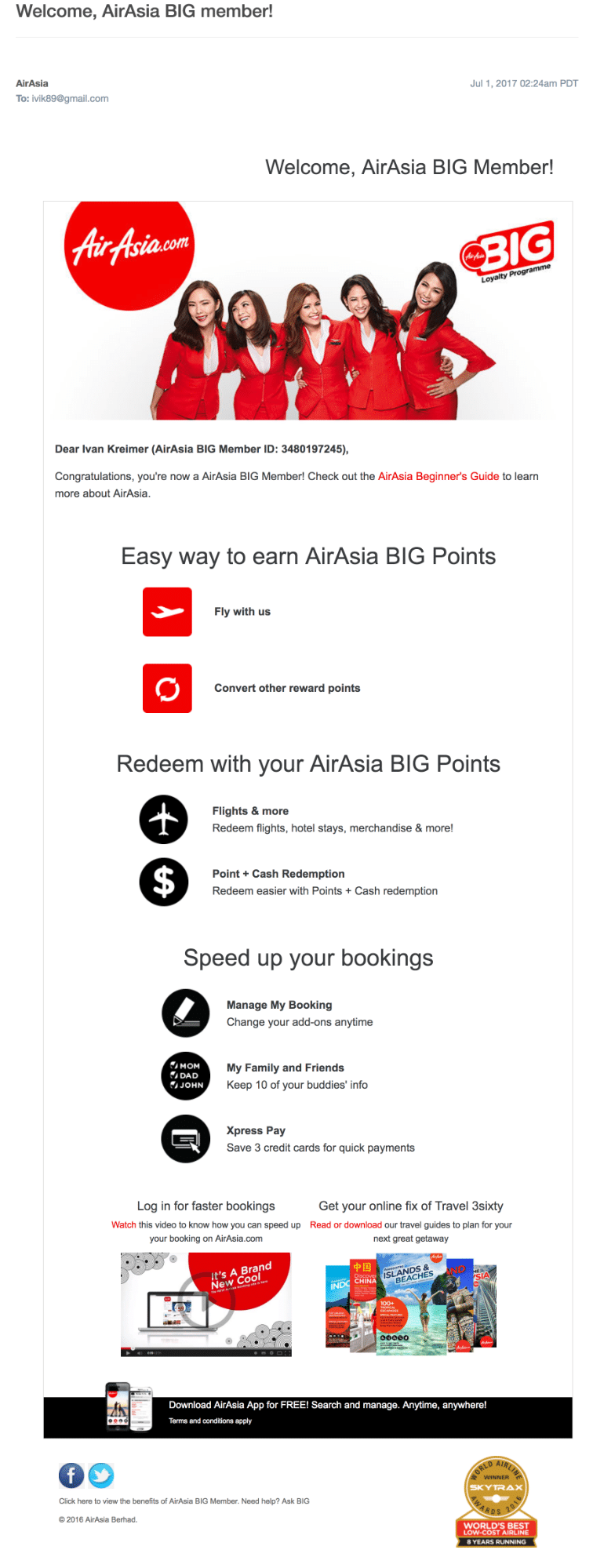
After I had booked a flight, I received a booking confirmation email. It’s simple and focused on the most basic links to manage my booking and check in. A few days before the flight, I received another email with the travel itinerary and the things I needed to bring to the airport.
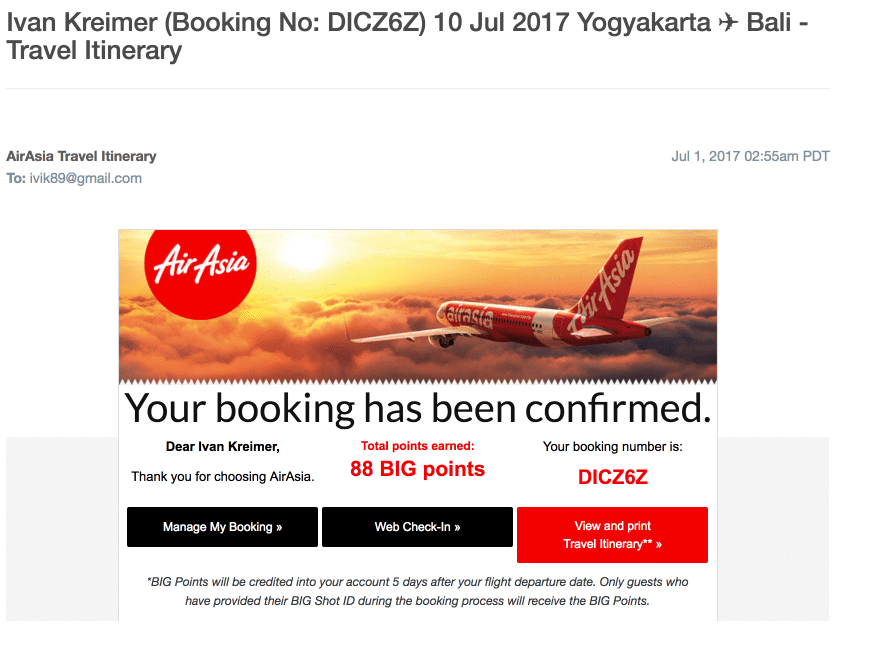
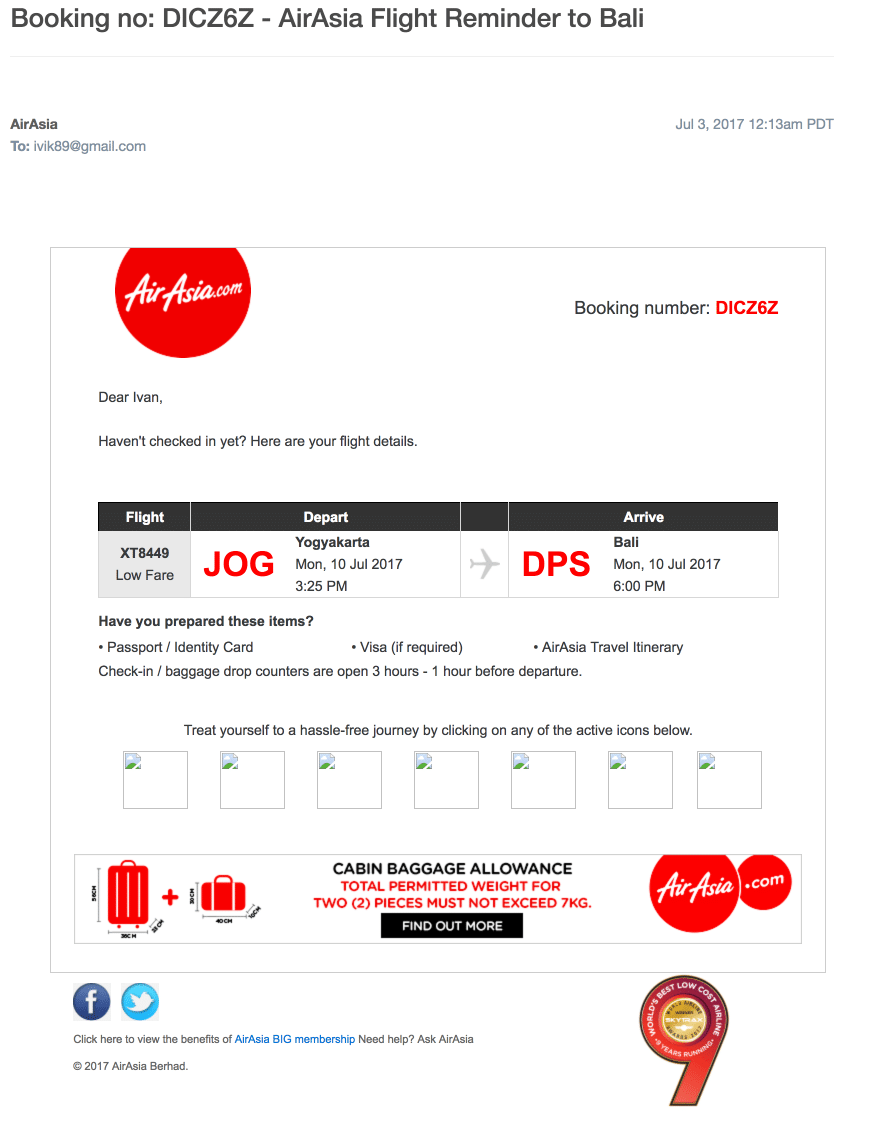
Once I made the flight, I received a customer satisfaction survey with the option of loyalty points. The reward ended up being enough incentive for me to take the survey.
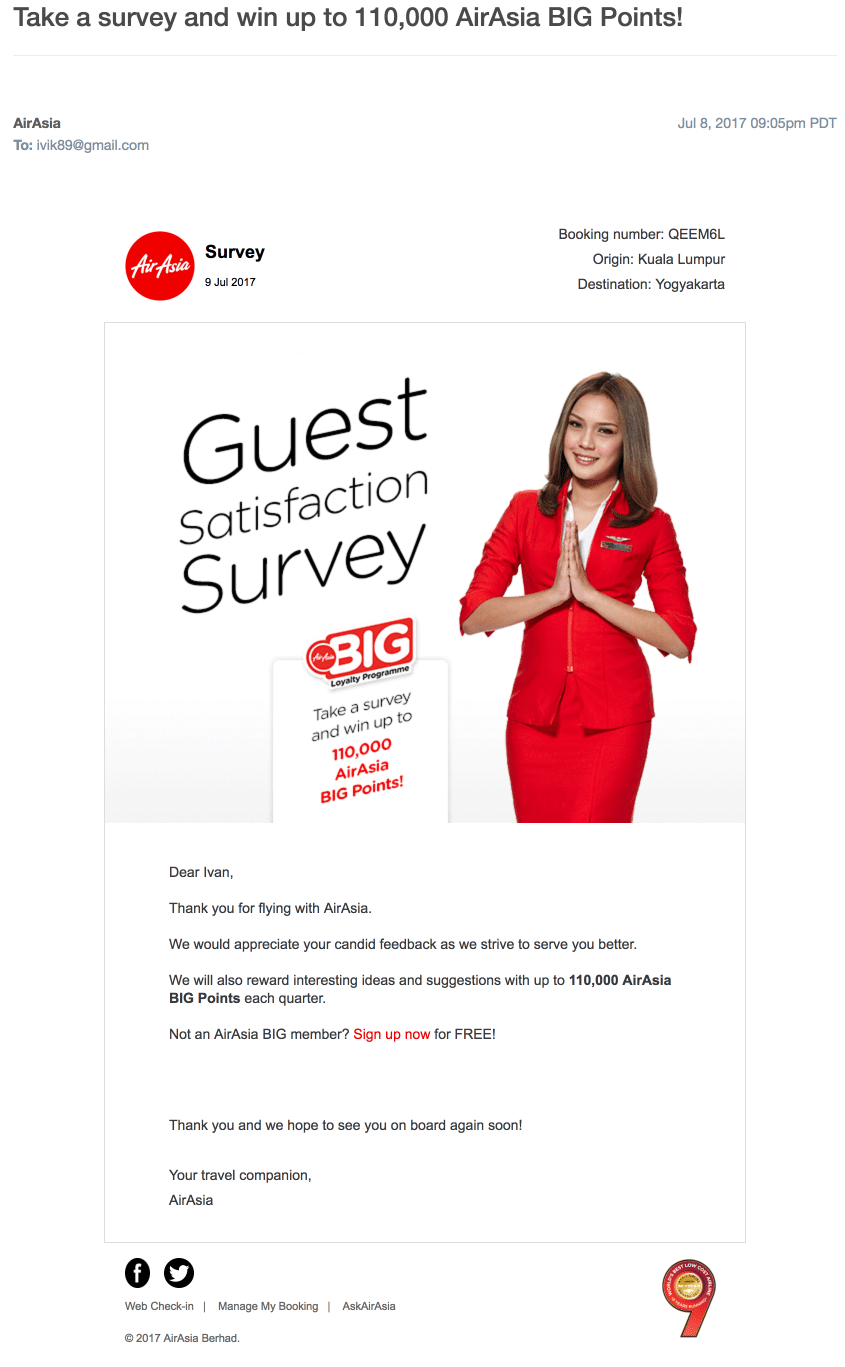
Wrap up
The companies you’ve seen in this post come from entirely different industries and all benefit from lifecycle marketing using email and automation. What they share is that they follow through on the basics of lifecycle marketing, meaning they consider and address each of the stages included in the customer lifecycle journey:
- Brand awareness
- Brand engagement
- Customer evaluation of the brand
- Customer purchase
- Post-purchase experience
- Customer advocacy
Now that you’ve gotten a chance to learn about lifecycle marketing, it’s time to focus your attention on creating customer journeys to help move them through the lifecycle marketing stages. Start by reading our guide on getting started with customer journeys and learn not only the basics, but how to set up customer journeys with the help of Campaign Monitor’s helpful tools.






